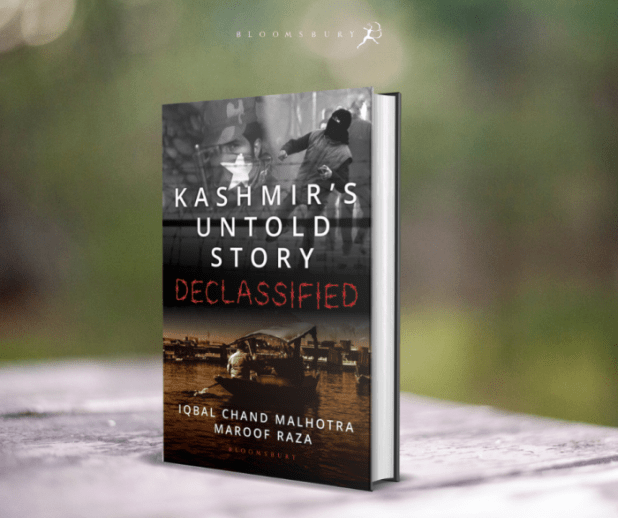
Kashmir’s untold story- Declassified by Iqbal Chand Malhotra and Maroof Raza ( Bloomsbury 2019) is a must read book for any one seeking convincing answers to two basic questions: First, why do the Chinese always stand by Pakistan and are so determined to consolidate their position in the occupied Aksai Chin and build China Pakistan Economic Corridor at enormous cost ? and second: why is the US support to Pakistan has been always so steady? The authors’ answers to these are straight forward: a heady mix of geopolitics and geoeconomics created these compulsions and that these are unlikely to change in the future- a bad news for us, the Indians.
However these are based on the analysis of hard evidence, facts and original thought.
It begins with the great geostrategic significance of the rise of Sikh empire in the 19th century under Maharaja Ranjit Singh in destroying first, the Afghan power structure to invade the Punjab Plains at will by securing Peshawar, the gateway to Kabul valley and subduing the Afghan warlords therein. And second, by extending for the first time in history the power of a state based in Indian heartland to a part of the Tibetan plateau in 1834 when the Sikhs under General Zarwar Singh captured Ladakh ;and third, in 1839 when occupation of Baltistan and Gilgit- Hunza brought the borders of the Sikh empire to Tsarist Russian empire in Central Asia . The signing of the Treaty of Chushul on September 17,1842 following the Sikh defeat in the conflict with the combined forces of Tibet and China between Raja Gulab Singh representing the Sikh empire and the Qing empire of China and the then Dalai Lama settled the boundaries of the two powers leaving the control of Ladakh, Aksai Chin,Baltistan and Gilgit-Hunza with the Sikh empire. Never in history a state based in Northern Indian Plains achieved such a strategic outreach as the Sikh empire did by 1839 – 1842.Even after positioning its successor state- Kashmir following the Treaty of Amritsar big power contests over these strategic areas shaped and continue to shape the unending ” “great game”in the 21st century. The fact that the Sikh conquests extended India’s frontiers to the Tsarist central Asia and Tibet for the first time in history is not highlighted in conventional history books and even in Kashmir studies. The authors thus did justice to those defining periods of Indian history.
The first Kashmir war triggered by the invasion of the valley by the Frontier tribesmen- Kabalis in October 1947 preceded by uprising of the Muslims of Poonch was really a British move designed to deny India control over the strategic Gilgit-Hunza- Baltistan land border with the USSR Afghanistan and access to Sinkiang in China ; because given the anti colonial and socialist tradition of India’s freedom movement, her size and power potential India could not be expected to toe the western line in the Cold war that started already. Hence the strategic importance of Pakistani control over the northern Kashmir territory for the British.
The authors’ analysis of the events, the roles of Sir George Cunningham, the British Governor of the North West Frontier Province, Generals- Frank Messervy and Gracey commanding the Pak Army in mentoring , planning and mobilising the tribal raids to Kashmir; and in particular the treacherous act of Major Brown of the Gilgit Scouts in organising a revolt against the authority of the Maharaja at Gilgit, hoisting Pakistani flag and declaring Gilgit Hunza a part of Pakistan establish in no uncertain terms that “tribal (Kabali) invasion was a move of the British “deep State” to further the western strategic interest. These were not just uprisings of Muslims against the Hindu Maharaja. This is further corroborated by the hard evidence that the British officers serving with the Pakistani Army took part in the Kashmir war when the Kabalis were being driven out by the Indian Army and the Pak Army moved in to save the situation. The authors referred to the death of Major R.E. Sloan,a British officer of the Pakistan Army in action in Kashmir war. There might have been more British Kashmir battle casualties. This was in total violation of the solemn assurance of the UK and the then Supreme Commander Field Marshal Claude Auchinleck that the British officers serving under both the Dominions would not take part in any future conflict between the two Dominions. On examination of facts on record the authors viewed the roles of the British Generals – Roy Bucher and Gracey who led the Indian and Pakistani Armies respectively ” treacherous” that led them to conclude that the First Kashmir war was a kind of “shadow boxing” as the British Generals ensured that the Indian intervention didn’t succeed to the point of removal of Pakistani forces from Muzaffarabad- Poonch and Gilgit Hunza Region as the British” deep state” was determined to deny India a land border with USSR in close proximity of emerging “Red China”. This also explains why Indian Army didn’t complete the task of clearing Kashmir of the Invaders and India settled for a UN sponsored cease fire in January 1949 dividing Kashmir in the process.
The consequences of Gilgit Hunza falling under Pakistani control was far reaching as in the same period- 1949-50 consolidation of the Chinese state took place under the Communist Party led by Mao Tse Tung. After taking over Tibet and Sinkiang in 1949-50 China started making inroads to Aksai Chin, a part of Kashmir. Though India’s borders with China were not demarcated, as early as 1899 a border that would run through Karakoram and Kashmir was drawn up by the British which came to be known as Macartney- MacDonald line which the authors mentioned still forms the boundary between Pakistan and China. China however made it clear that it didn’t recognize the Line as it went ahead to construct the Karakoram high way through a part of Aksai Chin. Further it viewed the Treaty of Chushul ” unequal”and thereby questioned its legitimacy . This paved the way for March 2 , 1963 Sino Pak Border Agreement resulting in the surrender of 13000 sq miles of territory by Pakistan to China which included Shaksgam River valley, “the home to over 242 glaciers and considered to be the most glaciated Region in the world outside the two poles” .
This was a huge strategic gain for China as Aksai Chin already provided her with an alternative access to Shaksgam River valley . This would not have taken place but for the British perfidy which enabled Pakistan to take over Gilgit Hunza Region. And this was one more strong reason for the authors to hold that the Chinese occupation of Aksai Chin made the Panchsheel Agreement signed much later by India an unequal one.
The acquisition of the Shaksgam River valley proved to be a boon and a veritable gold mine for China in the 21st century global politics when” economic strength became the currency of power” which in turn is founded on domestic capacity to produce micro chips essential for manufacturing most high value added products. Micro chips require two basic raw materials- sand and fresh water. A 30 cm silicon wafer requires almost 10000 litre of fresh water which China’s major rivers being choked with effluents can’t provide.
In this situation, a convenient location in Xinjiang close to both Taklamakan desert and Shaksgam valley would be ideal for manufacturing micro chips. Thus before long the Chinese polysilicon and silicon wafer producers were found busy setting up giant plants outside Kashgar. The authors conclusion that strategic control over the vast water resources stored in the lakes, rivers and glaciers in the Himalayan and Karakoram mountain ranges is the real driving force behind China’s Belt and Road Initiative (BRI ) is valid. This must be the Chinese real agenda to start China Pakistan Economic Corridor and the basis of ” all weather friendship ” between China and Pakistan.
The answer to the other question about continuing US support is more complex. It is partly a hangover of the British Foreign office view since Second world war that a strong, United India was not in the western strategic interest in the Middle East and the oil rich Gulf Region and especially so once the cold war began. There was also a perception that Pakistan could never be a functioning democracy like India and the British helped Pak Army to develop systems to undermine democracy right from the creation of Pakistani State. The ISI – the inter service intelligence was therefore founded by a British officer of the Pakistani Army,Maj.General W.J. Cawthorn in 1947 who was its head during the first Kashmir war and thereby laid the foundation of the” deep state” facilitating Army take over of Pakistan in 1958 – a development the West and US in particular endorsed. Hence Pakistan as a permanent client state has always been a strategic asset to protect US interest in the middle East, Afghanistan and central Asia and will continue to serve as such in the foreseeable future. One must recall that Dr. Kissinger’s (then US secretary of state ) secret July 21 1971 flight from Pakistan’s Peshawar to China was a game changer in global politics; and today Pakistan’s role is critical for success of February 29,2020 Doha Agreement that the US signed with the Taliban to end 18 year old war in Afghanistan – the longest involvement of USA in any conflict.
This being the big picture defining convergence of interests of China and Pakistan and US and Pakistan the authors’ point that Pak sponsored terror in Kashmir will continue seems realistic. Equally telling is their argument that ” funding the militancy in Kashmir costs Sino Pak syndicate a fraction of what it costs India to fight the same”. In this scenario the success of bold Indian initiative of reorganization of Jammu and Kashmir into two Union Territories would depend on how soon the Kashmiri Muslims of the valley realize that while the idea of ” Azadi” ( meaning Independence) might be desirable it is not achievable given (a) the military infrastructure that India has built in the valley over seven decades,(b) Kashmir’s mind boggling complex ethnic, religious and regional diversities ,(c) increasing stakes of the US, China, Japan and European Union in India’s economy ; and finally the reality that beyond logistics support to militants, Pakistan would not venture out to a war with India again. This is the core message of insightful study of Kashmir today.
[the_ad id=’22723′]


















